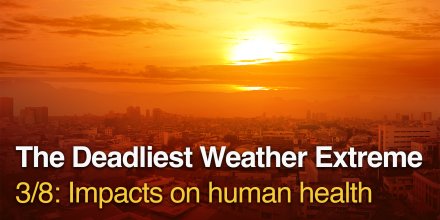This is a series of articles examining heatwaves from every angle, exploring their causes, consequences, and the science behind them. It includes eight parts:
- Introduction
- Heatwave patterns
- Impacts on human health
- Impacts on urban areas
- Extreme heat in 2024
- Are heatwaves linked to climate change?
- Adapting to more frequent periods of extreme heat
- Temperature, apparent temperature, and heat indices
Impacts of Extreme Temperatures and Heatwaves
Extreme heat has far-reaching and interconnected effects across society. It triggers cascading events such as wildfires, droughts, storms, water shortages, food insecurity, and infrastructure disruptions—phenomena that can affect multiple sectors or regions simultaneously and amplify the impacts of other hazards.
Health impacts of extreme heat on the human body
The measured temperature indicates the air temperature in the immediate surroundings, but on its own, it is not sufficient to determine how it will be perceived by the human body. The same temperature reading can feel entirely different in a city, in the mountains, or by the sea. How we actually experience heat or cold is influenced by a number of additional factors. The most important among them are air temperature, solar radiation, humidity, and wind. These external conditions affecting the human body are collectively referred to as thermal stress, which can significantly increase during periods of extreme heat and lead to serious health risks.
Prolonged extreme heat poses a serious risk to human health. When the body is unable to effectively regulate its internal temperature and release excess heat, heat stress can occur. This may lead to heat exhaustion or, in more severe cases, to heatstroke.
The increased demand for thermoregulation also places significant strain on the heart and kidneys. As a result, extreme heat can worsen the course of chronic illnesses, particularly cardiovascular, respiratory, mental health, and diabetic conditions. In some cases, it may also contribute to acute kidney problems.
The extent and severity of health impacts depend on the timing, intensity, and duration of the heatwave, as well as on how well the local population, infrastructure, and institutions are adapted to current climate conditions. Particularly vulnerable groups include the elderly, young children, outdoor workers, people with disabilities, individuals with chronic illnesses, and residents of urban areas.
The map shows a rise in tropical nights (temperature does not drop below 20°C) across the city of Zurich from 2020 to 2024, driven by extreme summer heat and the urban heat island effect. Prolonged exposure to high nighttime temperatures poses growing health challenges, particularly in densely built areas and especially affecting vulnerable populations, such as the elderly, infants, and those with pre-existing conditions.
Heat-related mortality
Among all extreme weather events, extreme heat is the leading cause of death worldwide. Deaths caused by extreme heat often occur very rapidly, either on the day of the extreme heat stress or shortly afterward.
According to estimates, between 2000 and 2019, there were approximately 489,000 heat-related deaths per year worldwide, with the highest proportions recorded in Asia (45%) and Europe (36%). These figures are only indicative. The health impact of extreme heat is often underestimated, as deaths are frequently attributed to other causes, even though they might not have occurred without the influence of heat. In many cases, such deaths are not recorded at all, and many countries lack complete mortality statistics.
Heatwaves also can indirectly contribute to mortality through accompanying phenomena such as drought, deteriorating water quality, wildfires, or the failure of critical infrastructure. As a result, quantifying their true impact on human health is very challenging.
Explore how our tools help you prepare for heatwaves: Urban Heat Maps offer hyper‑local temperature insights tailored to city planning and public health, climate+ provides long-term modelled and observed climate data for strategic adaptation, and point+ delivers precise, customizable weather forecasts for any location.
This article is based in part on original work provided by Jaroslava Sochorova (Windy.com), which has been adapted and edited by meteoblue.



